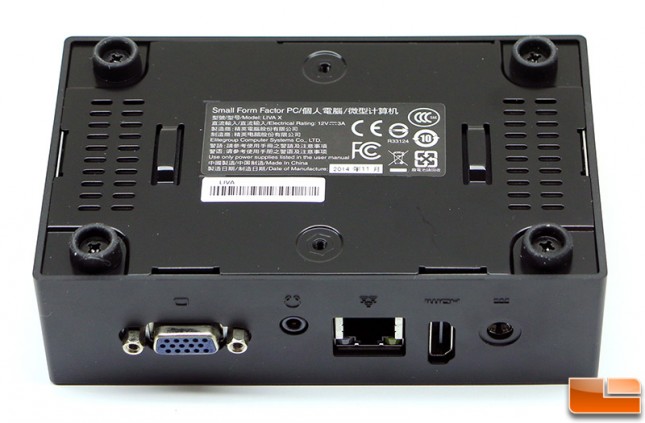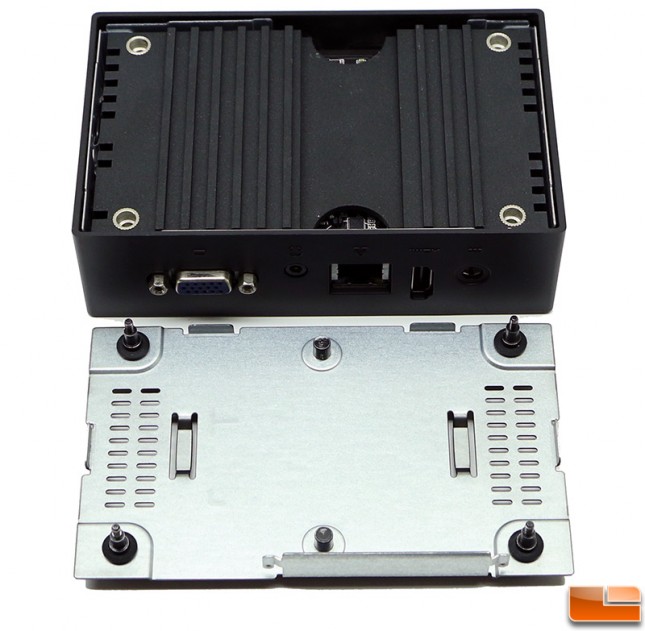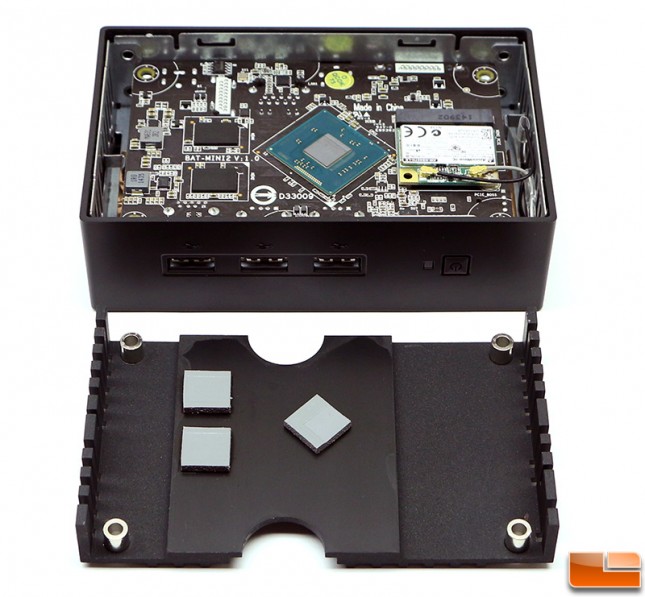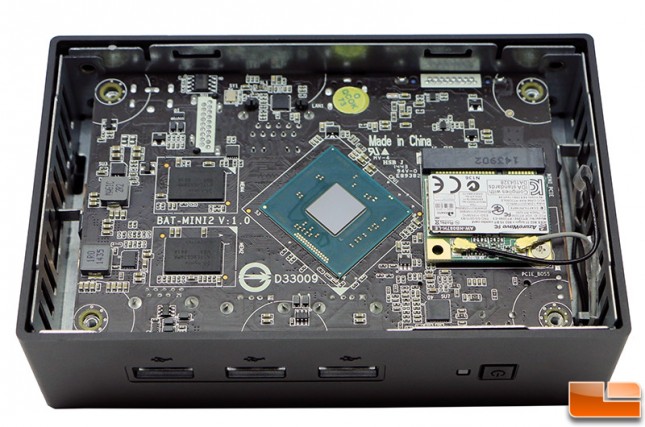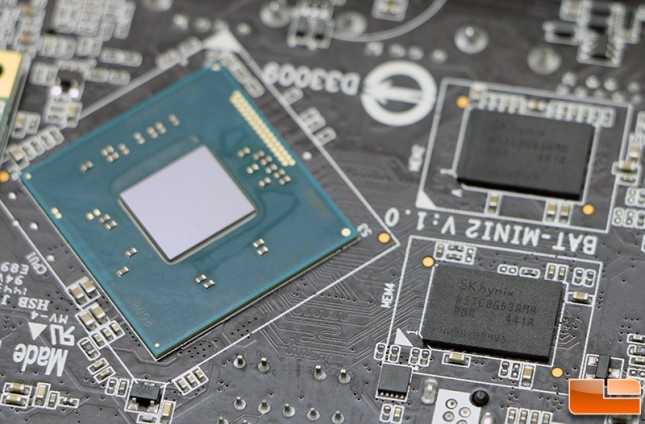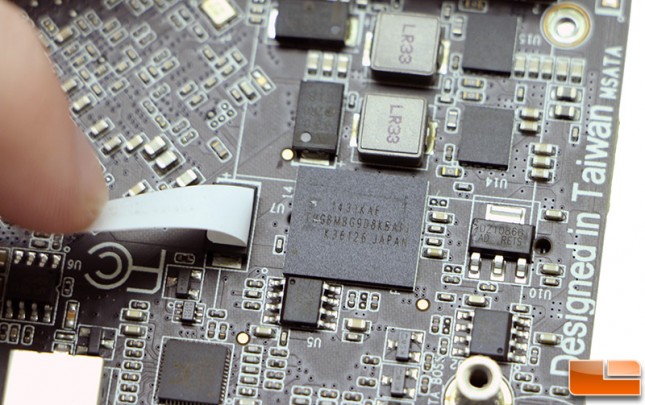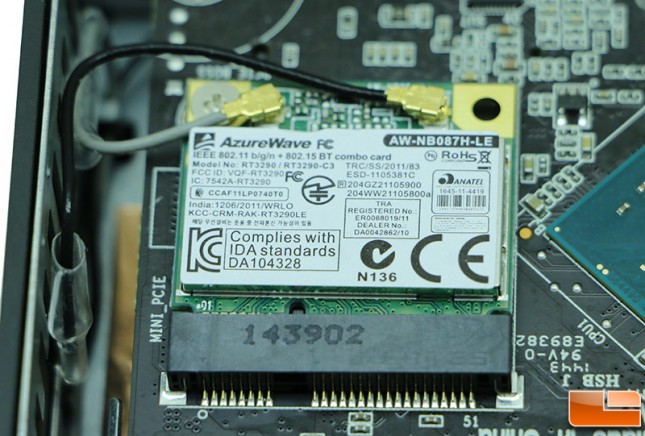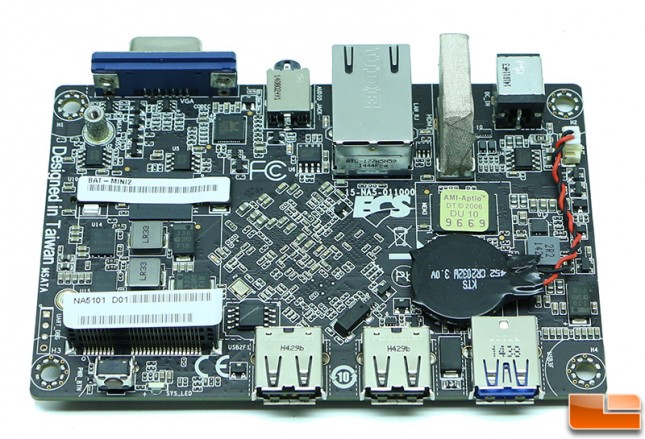ECS LIVA X 64GB Mini PC Kit Review
Inside The ECS LIVA X – The BAT-Mini 2 Motherboard
The bottom of the ECS LIVA X has four rubber feet to keep it from moving around on any surface and inside those feet are four Philips screws that can be loosened to remove the bottom plate. The only reason you need to really enter the LIVA X is in the event that you need to add a mSATA SSD for expanded storage. The two screw holes recessed into the middle of the case are for the VESA mounting bracket. The ECS LIVA X supports 75mm and 100mm VESA mounts.
With the lower plate removed from the LIVA X you can see that there is a large passive heatsink that spans the entire width of the enclosure to keep the CPU cool. Since no fans are needed to cool the LIVA X it means that this is a silent 0dB mini PC!
The heasink is held down by the bottom of the LIVA X enclosure, so to remove it you simply lift it off with the two access holes. Note there are three 5mm thick thermal pads that help dissipate heat away from the Intel Celeron N2808 SoC and two DDR3L memory chips.
Here is a look inside the ECS LIVA X with a passive cooling solution removed. Here is a look at the back side of the BAT-MINI2 board and the mSATA slot is loacted on the left hand side underneath a barcode sticker.+
We discovered two SKhynix 1333MHz single channel DDR3L memory ICs with part number H5TC8G63AMR that make up the ECS LIVA Xs 4GB of integrated memory. These are 8Gb low power DDRIII synchronous DRAM chips that use 1.35V of power.
The 64GB of Embedded Memory (eMMC) is handled by a Toshiba NAND Flash Memory chip labeled 7HGBMBG9D8KBATG that was made in Japan. This embedded NAND Flash memory module is built on the 19nm fabrication process and the entire package measures just 1.5 x 13 x 1.0mm in size. This 64GB Toshiba eMMC chip is compliant with JEDEC e.MMC Version 5.0, published by JEDEC in September 2013, and achieves a high read/write performance by applying the new HS400 mode that offers additional improvement in terms of interface speed (up to 400 MB/s vs 200 MB/s in the prior version). Toshiba says that this series of e-MMC NAND should be capable of hitting up to 275MB/s read and 90MB/s write in Sequential Interleave Mode.
When it comes to the Wi-Fi module, ECS includes the AzureWave AW-NB087H-LE 802.11b/g/n half size mini PCIe wireless solution. The AW-NB087H-LE is also Bluetooth 3.0 HS and 4.0 compliant. This card is powered by the Ralink RT3290LE, if you are curious what SoC is powering this module. How will wireless performance be with this specific solution? You are looking at a single-band (2.4 GHz network only) single stream solution (1×1), so one should be able to get speeds of up to 150 Mbps. We really like the fact that ECS ditched the M.2 SDIO wireless card interface found on the original ECS LIVA in exchange for the more popular mini PCIe interface as you can now easily upgrade to a higher-end 802.11ac wireless card if one wanted to down the road. We’ve never used this wireless card, but it isn’t anything fancy.
The unoccupied mSATA slot is found on the other side of the board. The mSATA slot on the ECS LIVA X uses the SATA II interface. In order to access the other side of the board you need to remove the standoffs next to the VGA port and then the board will be able to be removed from the chassis. If you wanted to run an OS like Windows 7 you must use an mSATA SSD as that is the only way to get storage drives to work with Windows 7. Notice anything missing for the mSATA drive? ECS forgot to include the screw needed to hold down the mSATA card, so when we went to install one of our mSATA SSDs we had to go hunting for a screw in our part bucket to secure the drive. Whoops!
Let’s build this system and move along to testing!

